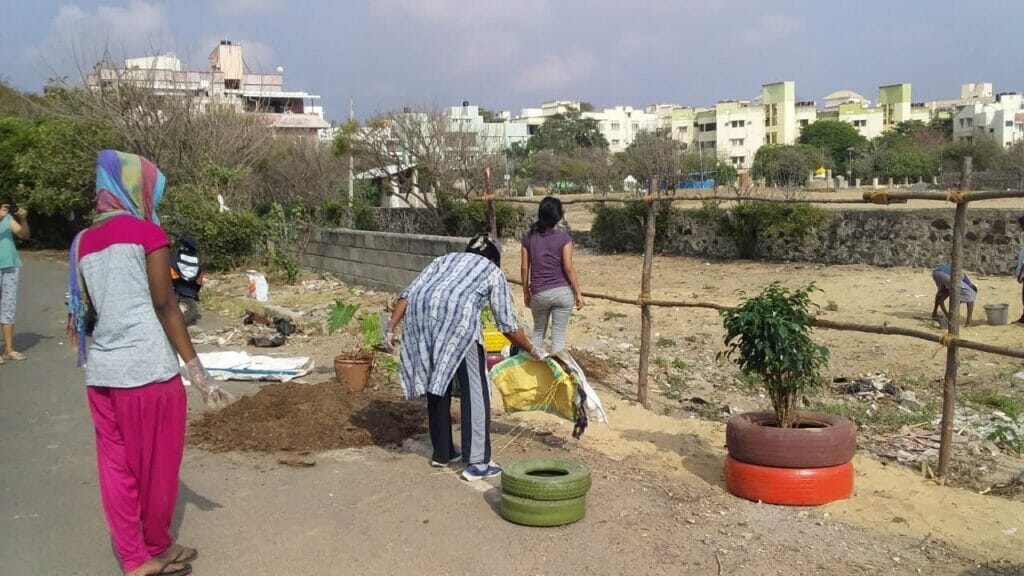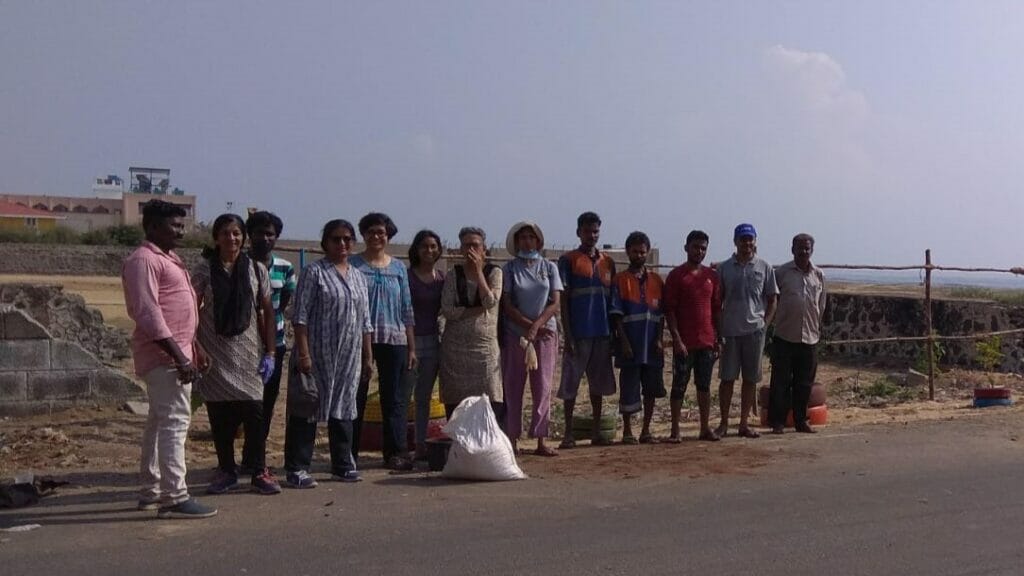A common sight across Chennai is garbage bins overflowing with unsegregated waste, with some of it pooling on the ground around the bins. The stench emanating from the bins is bound to make anyone gag. Not only are the sight and smell unpleasant, but they are also a recipe for health and environmental hazards. With this in mind, the residents of Valmiki Nagar in Thiruvanmiyur have been able to do away with large garbage bins that had been placed on the street.
The residents managed this feat with meticulous source segregation, constant dialogue with the community and ensuring that the need for street-side bins was eliminated to a large extent.
Such methods can be adopted by residents across Chennai, with some tweaking according to the local context to eliminate street-side bins across the city.
Read more: Can Chennai ever become a bin-less city?
Roadmap for eliminating bins in Valmiki Nagar
A group of 13 active residents in the community took the initiative to rid Valmiki Nagar of street-side garbage bins.
Our idea was to get all the residents to segregate waste in the apartment complexes in the area. When we started, we addressed the office bearers of the Valmiki Nagar Resident Welfare Association about the importance of waste segregation and the need to eliminate street-side garbage bins.
We also created a WhatsApp group with a minimum of one representative from every apartment complex. This person was tasked with conveying our messages on solid waste management to the residents. They were also able to reach out to the team for any clarification.
Once this message was conveyed to all the residents, we proceeded to lay out the plan to go binless.
We requested each apartment complex to procure a 25-litre bin for kitchen waste. The smaller bin is easier to handle for the conservancy team. Kitchen waste is not voluminous but weighs a lot. Further, apartment complexes were requested to procure separate bins for hazardous waste. Finally, the apartment complexes were to place a 100-litre or 200-litre bin for recyclable waste as this waste is voluminous. We also provided a list of shops where the bins are available and those who will deliver the bins.
We also spent time creating awareness about source segregation and distributing pamphlets to residents explaining how to go about separating their household waste.
The apartments were given a time period of 15 days to begin source segregation. With buy-in from the community, the apartment complexes procured large bins to be placed inside the premises to deposit waste.
Residents started discarding segregated waste into these 100-litre bins stored within their apartment complexes. This segregated waste would later be collected by the conservancy workers.
Removal of bins in Valmiki Nagar
A large part of the reason for the street-side bins to exist was to hold the waste from the apartment complexes in the area.
Once the apartment complexes were able to manage their waste within the premises, the need for large garbage bins on the streets was eliminated. The process which was initiated in October 2019 took six months to come to fruition.
With consensus from the civic body, the bins were removed from Valmiki Nagar.
Once this was achieved, the residents who had been working to remove the bins decided to beautify the areas from which they were removed.
We placed tires and potted plants on the stretches where the garbage bins sat on the road. The goal of this move was that in a beautified area, people will think twice about littering.

To prevent people from littering on the roads, we also asked the residents in the surrounding areas to exercise vigilance.
We also put up a board that read “People are not allowed to throw garbage on the road. If not, they will be fined Rs. 500 [as per the solid waste management bye-laws of the civic body].”
We found a was a garbage-vulnerable point where people come and often dump trash once the bins had been removed. We pooled some money and hired a watchman to prevent people from indiscriminately littering the area.
Challenges in removal of bins in Valmiki Nagar
Not all of this was smooth sailing. Residents faced hiccups in source segregation, a problem that could have hampered the entire exercise to go binless.
The few apartments which did not comply with source segregation were informed that the larger bins on the roads in Valmiki Nagar would be removed. Therefore, they had no choice but to segregate waste and hand it over to the conservancy workers.
Read more: Why I segregate waste at source despite a broken waste management system in Chennai
Another hurdle that came along the way was when informal waste pickers hired by private agencies for a monthly charge came to collect plastic, paper and other recyclable waste in some apartments.
This was when the conservancy workers did not regularly do door-to-door garbage collection, and the garbage bins on the roads in Valmiki Nagar were still present during the initial days of our awareness creation.
The workers used to dump waste they did not see any value in the large bins on the road.
Once the plans to go binless were in place, we roped the informal waste pickers into the system. We requested they not dump waste in the area and to help with waste segregation in the apartment complexes at the source.
The waste pickers who were on board with the plan were enrolled as supervisors for around nine months along with the conservancy team to check on source segregation.
They helped improve source segregation across apartments and were paid Rs. 5000 every month for their services.
Also, once the conservancy agencies changed, a waste picker got a job with them, while the others preferred to be freelancers.
Points to remember about going binless
- Ensure the door-to-door collection happens in each household
- Communicate the expected timeline before the removal of bins to all residents
- Spread awareness about source segregation and ensure residents receive clear instructions
- Once bins are removed, ensure residents do not resort to littering
Effect of removal of bins in Valmiki Nagar
Most of the residents were glad that the garbage bins on the road were removed. The streets became cleaner, and no more littering occurred.
The move also inspired others to keep the area clean. Vegetable vendors and autorickshaw drivers in the area were often found discouraging people from littering after bearing witness to our efforts to ensure cleanliness.
We were able to remove a total of 15 bins from 7 locations in Valmiki Nagar through these efforts.
At present, the segregation efforts continue to take place in all apartment complexes on 7th Street, including all the housing board complexes on 1st Seaward Road.

Some of the key learning from this exercise has been that to go binless, there should be constant and effective communication about source segregation. Moreover, the logistics for door-to-door collection must be strengthened. The segregated waste must also be collected and taken to wet and dry waste processing facilities without any hassle.
Only when these fundamentals are in place can residents be convinced of the removal of street-side garbage bins.
Phenomenal effort by Ms. Jayanthi and other activist residents of Valmiki Nagar. We at Adyar learnt a lot from her pioneering work. All the very best.